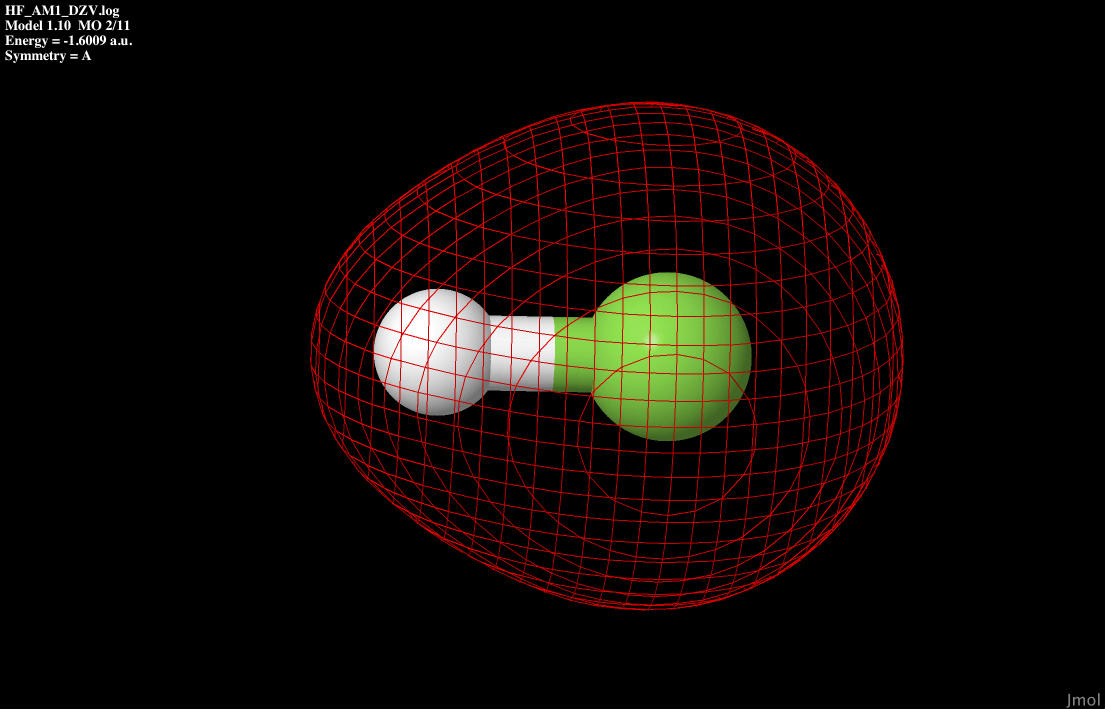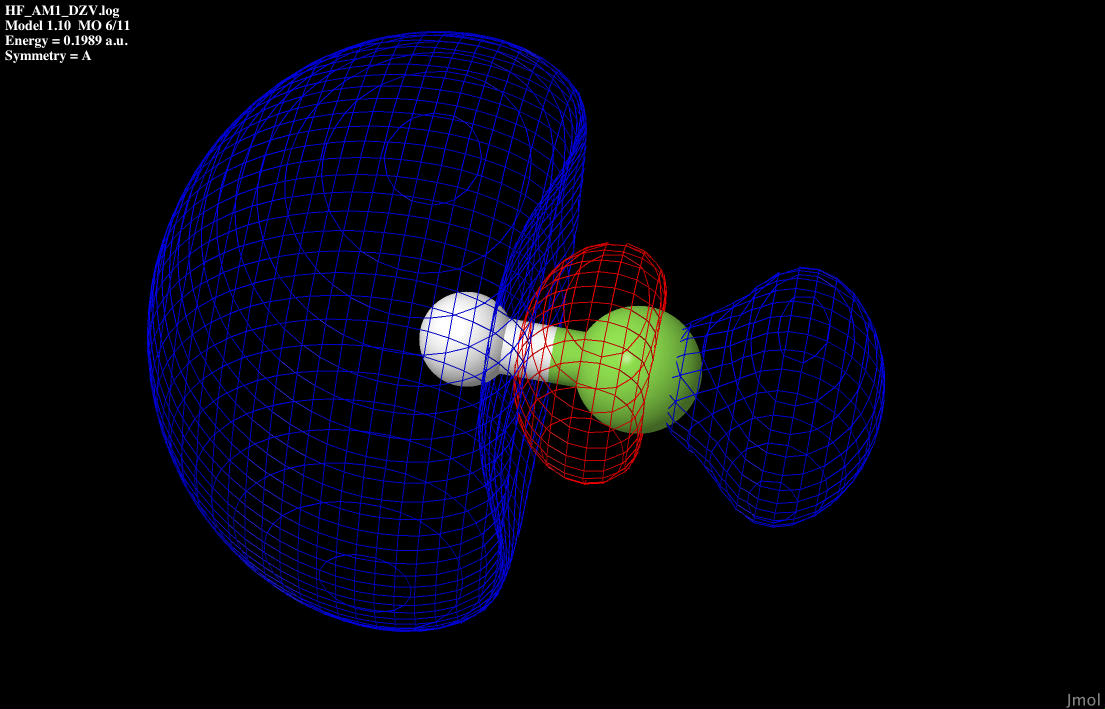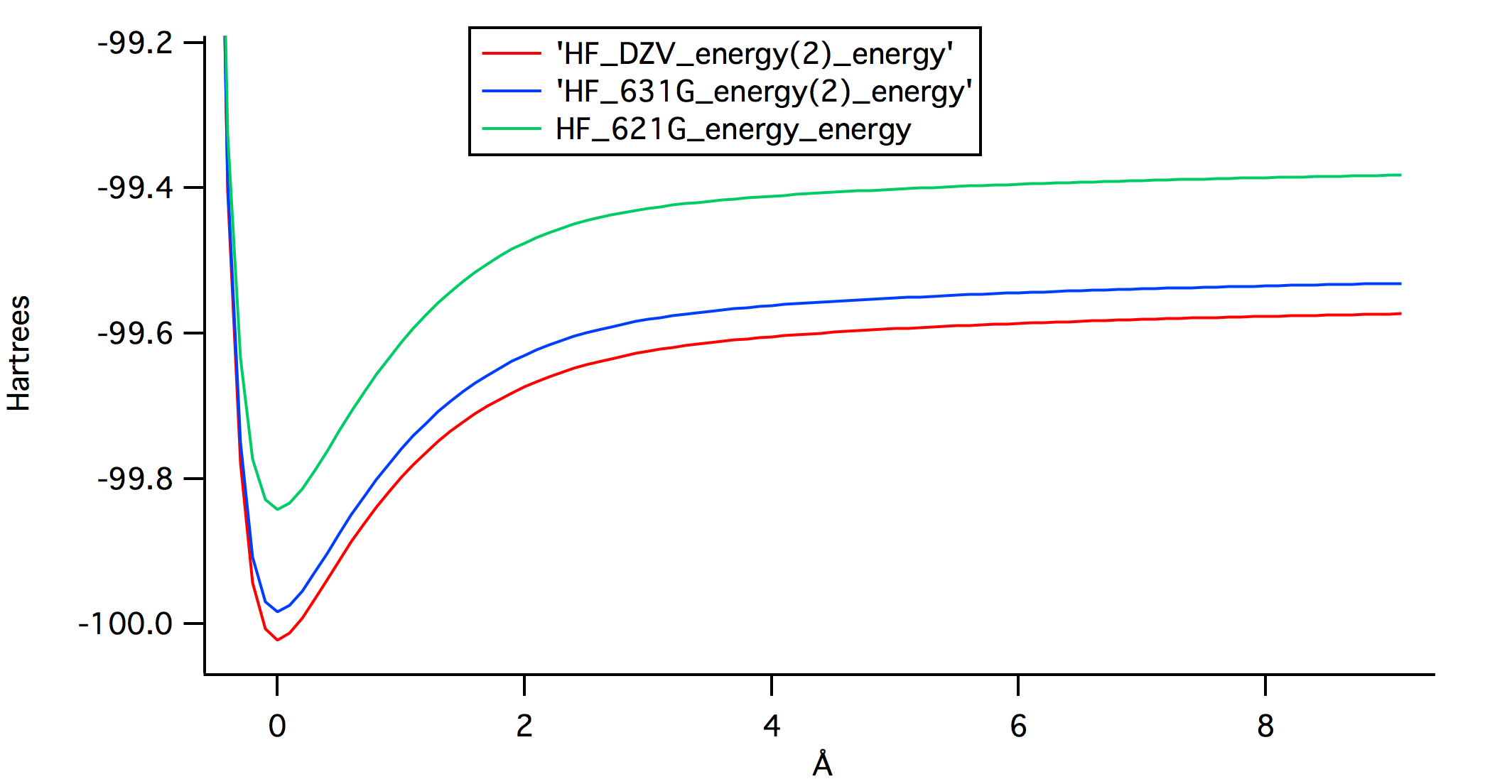Once the molecule file is fully loaded, the image at right will become live. At that time the "activate 3-D" icon ![]() will disappear.
will disappear.
Hydrogen fluoride
Geometry optimization in MacMol was used to arrive at the lowest
energy geometry of the molecule. Five levels of optimization were
used: AM1, PM3, 6-21G, 6-31G, and DZV. It was found that the most
energetically favorable orientation was the DZV optimization. The
literature value of the bond length of hydrogen fluoride 0.917
angstrom.5 In the image to the right, the green atom is fluorine and the
white atom is hydrogen. The optimization AM1 was further optimized using the 6-21G. The 6-21G optimization is the lowest level of optimization found in the ab initio.
The AM1 was further optimized using the 6-31G. This could have been done using the previous 6-21G optimization, but since it is a diatomic molecule it is not essential. The result in the 6-31G optimization had an equivalent bond length to the DZV optimization.
The DZV is the highest level of optimization in the ab initio. This optimization was derived from the AM1 optimization. Again, this could have been derived from the previous 6-31G optimization, but because it's a diatomic molecule it was not essential.
The HOMO is the highest occupied molecular orbital. This orbital is calculated by adding the electrons in each atom and then dividing by two. In the case of hydrogen fluoride, there are 10 electrons, so the HOMO orbital is the fifth orbital.
The LUMO is the lowest unoccupied molecular orbital. This orbital is found by moving up to the next highest orbital from the HOMO. In this case, it was the sixth orbital. No electrons are normally here, however the electrons can be excited to the LUMO.
The electrostatic potential is a representation of the electric potential energy as it varies throughout the molecule. In the image, the red area represents a higher density of electrons and thus a higher electric potential energy. The blue area represents a lower density of electrons and thus a lower electric potential energy. The diagram shows that most of the electrons stay around fluorine which makes sense because of fluorine's high electronegativity and hydrogen's low electronegativity.
Because of fluorine's high electronegativity, the molecule is polar which results in a negative partial charge on fluorine and a positive partial charge on hydrogen.
Table 1: Valence energy level diagram table increasing in energy
| Bond Type |
Orbital Diagram |
Energy Level |
| Sigma 1s2s bonding orbital |
 |
-1.5882 Hartrees |
| Sigma 1s2p bonding orbital |
 |
-0.7375 Hartrees |
| 2p non bonding orbital |
 |
-0.6307 Hartrees |
| sigma 1s2p anti-bonding orbital |
 |
0.2086 Hartrees |
Table 1 shows the molecular orbitals found at different energy levels for hydrogen fluoride. There is a degenerate orbital in the 2p orbital at a 90 degree rotation. The table starts at the lowest energy orbital and increases to the highest orbital. These energy levels are obtained from the DZV optimization.

Figure 1: Potential energy curve of each optimization for HF
In figure 1, the energy of each optimization is compared to show the DZV optimization is the lowest. DZV is the lowest because in the HF-SCF approximation the DZV uses more gaussians on the valance orbitals than the 6-21G and 6-31G resulting in a lower energy.
Table 2: Dipole Moments of HF at Different Optimization Levels
| Level of Optimization |
Dipole Moments (Debeyes) |
| 6-21G |
1.87 |
| 6-31G |
1.82 |
| DZV |
2.03 |
The dipole moment in HF is 1.82 debeyes in literature.5 The experimental value was found to be 1.80 debeyes using the 6-31G optimization. This yields an error of 1.10%. The 6-31G resulted in the approximation for the dipole moment.
The literature value for vibrational frequency is 4138.39 cm^-1.5 The experimental value found was 4234.31 cm^-1 using the DZV optimization. This yields an error of 2.32%.
Based on template by A. Herráez as modified by J. Gutow
Page skeleton and JavaScript generated by export to web function using Jmol 14.2.12_2015.01.22 2015-01-22 21:48 on Mar 2, 2015.
This will be the viewer


If your browser/OS combination is Java capable, you will get snappier performance if you use Java